I never thought I'd find a cookie that reminds me so much of home until I started making these Ube Tea Cookies. If you've ever had store-bought ube treats and thought "this doesn't taste like my mom's cooking," you're going to love this recipe. These soft, purple cookies taste just like real ube - not the artificial flavoring we often find in stores.
Don't worry if you're new to baking, these cookies are surprisingly easy to make. All you need is ube powder, some basic baking ingredients, and about an hour of your time. They're perfect with coffee or tea, and make wonderful gifts for friends and family. My kids love helping me shake the cookies in the sugar coating, and they always sneak a few while they're still warm.
Whether you're Filipino missing the taste of home, or just curious about ube, these cookies are a must-try!
Cultural Notes
Ube (Filipino Purple Yam) has been a staple in Filipino desserts for generations. These cookies represent a modern twist on traditional ube halaya, making the beloved flavor accessible in a convenient cookie form. Perfect for introducing Filipino flavors to those new to our cuisine.
Jump to:

Why You'll Love This Recipe
- Authentic Filipino flavor without artificial additives
- Melt-in-your-mouth tender texture
- Beautiful natural purple color
- Perfect balance of sweet and subtle ube flavor
- Great make-ahead option for parties or gifts
- Traditional Filipino merienda (afternoon snack)
- Healthier alternative to store-bought versions
Ingredients
The ingredients in these Ube Tea Cookies were carefully selected to create an authentic Filipino treat. Ube powder is the star, providing the distinct earthy-sweet flavor and natural purple color that makes these cookies special.
Cold butter creates flakiness, while coconut milk powder adds a subtle tropical note that perfectly complements ube, a classic Filipino pairing. The minimal sugar lets the natural ube sweetness shine through rather than overwhelming it.
These simple ingredients work together to create cookies that taste genuinely Filipino, avoiding artificial flavors or unnecessary spices that would mask the true essence of ube.

- 1 cup ube powder
- ½ cup all-purpose flour
- ¼ cup coconut milk powder
- ¼ cup powdered sugar
- ¼ teaspoon salt
- 1 large egg, room temperature
- 4 oz (113g) unsalted butter, cold and cubed
- For the Sugar Coating:
- ½ cup powdered sugar
- ¼ cup ube powder
Equipment
- Food processor - Essential for properly mixing ingredients and creating the right texture
- Rolling pin - For rolling the dough to the correct thickness
- 1-inch round cookie cutter - Creates perfectly sized, uniform cookies
- Baking sheets - You'll need at least two for batch baking
- Parchment paper or silicone baking mat - Prevents sticking and ensures even baking
- Measuring cups and spoons - For precise ingredient measurements
- Wire cooling rack - Allows cookies to cool properly without becoming soggy
- Airtight container - For storing finished cookies
- Kitchen scale - Optional but recommended for precise measurements
- Plastic wrap - For wrapping and chilling dough
- Ziplock bag - For coating cookies in sugar mixture
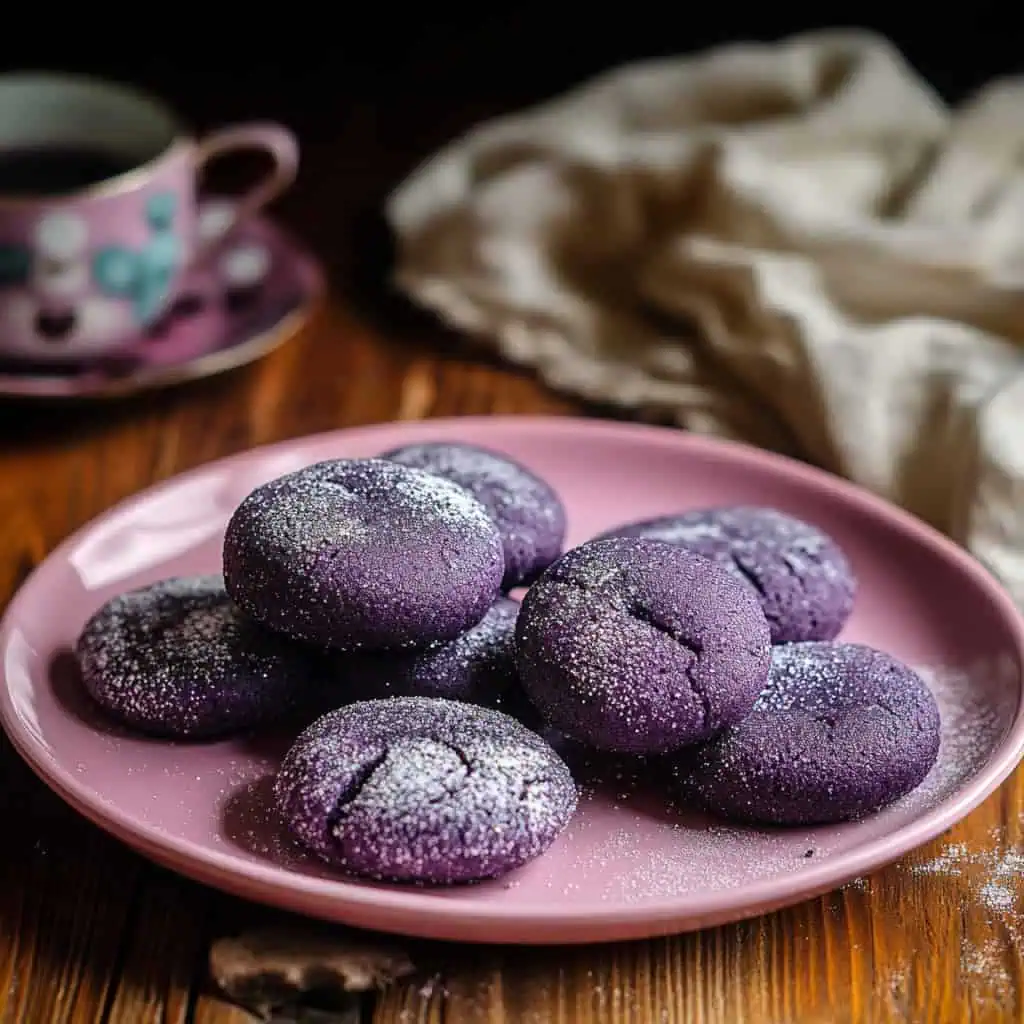
How To Make
- Place ube powder, flour, powdered sugar, salt, and coconut milk powder in your food processor. Pulse these dry ingredients together for 2-3 minutes until well mixed.
- Take your cold butter, cut it into small cubes, and add it to the processor. Pulse until the mixture looks like sand. Add your egg and pulse again until you have a soft dough.
- Line your counter with plastic wrap. Place the dough on it, gently flatten it a bit, and wrap it completely. Put this in your refrigerator for one hour to rest – this is important for the best texture.
- When ready to bake, heat your oven to 300°F (150°C). Line your baking sheets with parchment paper or a silicone mat.
- Take the chilled dough and roll it out until it's ½ centimeter thick. Use a 1-inch cookie cutter to cut out small circles. Gather any leftover dough, roll it out again, and keep cutting circles until you've used all the dough. If the dough gets sticky while working, pop it in the freezer for 5 minutes to firm up.
- Place your cookie circles on the lined baking sheets, leaving about an inch of space between each one. You'll probably need two baking sheets.
- Bake for 15 minutes until the edges are set but not browned. Let them cool completely on a wire rack.
- For the final touch, mix ½ cup powdered sugar and ¼ cup ube powder in a ziplock bag. Once the cookies are fully cooled, place them in the bag and gently shake until they're evenly coated.
Yield: About 62 mini cookies

Tips from Lola's Kitchen
- Cold butter is crucial - It creates pockets of steam during baking that result in the flakiest texture
- Don't overprocess the dough - Stop mixing as soon as it comes together to prevent tough cookies
- Chill properly - The full hour of chilling isn't optional; it allows the gluten to relax and the butter to firm up
- Measure precisely - Use a ruler to ensure uniform ½ centimeter thickness for consistent baking
- Rotate baking sheets - Halfway through baking, turn them 180° for even browning
- Patience pays off - Allow cookies to cool completely before coating or they'll absorb too much sugar
- Handle gently - These delicate cookies can break easily; transfer them carefully
- Quality matters - Use the best ube powder you can find for the most authentic flavor
Substitutions
- Ube powder: If unavailable, purple sweet potato powder can work, though the flavor will be less authentic. Never substitute artificial flavoring for real ube.
- Coconut milk powder: Regular milk powder with ¼ teaspoon coconut extract can be used, though the flavor won't be identical.
- Butter: High-quality margarine can work in a pinch, but expect a different texture and slightly altered flavor.
- Egg: For a vegan version, use 3 tablespoons of aquafaba (chickpea liquid), though the cookies will be slightly less rich.
- All-purpose flour: Cake flour can be substituted for an even more delicate texture.
Troubleshooting
- Cookies spreading too much?
- Your dough might be too warm - chill it longer, even between batches
- You might have used too much butter - double-check your measurements
- Oven temperature might be too low - use an oven thermometer to verify
- Cookies too hard?
- They were likely overbaked - reduce baking time by 1-2 minutes
- You might have used too much flour - measure by spooning into measuring cups, not scooping
- The dough might have been overworked - pulse minimally in food processor
- Sugar coating not sticking?
- The cookies might still be warm - ensure they're completely cool before coating
- The coating mixture might be too thick - sift powders together before using
- Try pressing the coating gently onto the cookies instead of just shaking
Storage & Reheating
- Room temperature: Store in an airtight container for up to 1 week
- Refrigerator: Keep fresh for up to 1 month in a sealed container
- Freezer: Uncoated cookies can be frozen for up to 3 months; wrap tightly in plastic wrap and place in a freezer bag
- Make-ahead: The dough can be refrigerated for up to 3 days or frozen for up to 1 month
- Refreshing: To crisp up cookies that have softened, place them in a 300°F oven for 3-5 minutes, then cool completely before enjoying

FAQ
Why use ube powder instead of fresh ube?
Ube powder provides more consistent results, has a longer shelf life, and is much easier to work with than fresh ube, which requires extensive preparation.
Can I make larger cookies?
Yes, you can use a larger cookie cutter, but you'll need to increase the baking time by 2-3 minutes and adjust cooling time accordingly. Watch them carefully to avoid over-browning.
Why are my cookies not purple enough?
The quality and concentration of ube powder varies greatly between brands. Look for premium Filipino brands for the most vibrant color. Never substitute with artificial coloring, as it won't provide the authentic flavor.
How do I know when the cookies are done?
The edges should be set but not brown. The centers will still be slightly soft but will firm up as they cool. If they brown, they'll be too crisp rather than having that signature melt-in-your-mouth texture.
Can I add other flavors to these cookies?
While you can experiment with additions like vanilla extract or almond extract, traditional ube cookies let the natural ube flavor shine. Adding chocolate chips, shredded coconut, or a touch of matcha powder to the coating can create interesting variations.
Why did my cookies crack?
Some cracking is normal and gives them a rustic appearance. Excessive cracking usually means the dough was too cold when baked or the oven temperature was too high.
Related
Looking for other recipes like this? Try these:
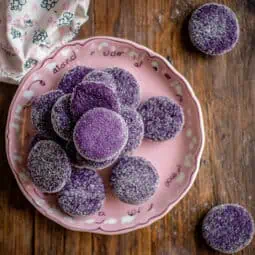
Filipino Ube Tea Cookies (Ube Shortbread Cookies)
Equipment
- Food processor (para sa paghalo ng mga sangkap / for mixing ingredients)
- Rolling pin (panggulong ng masa / for rolling dough)
- 1-inch round cookie cutter (pamputol ng biskwit / for cutting cookies)
- Baking sheets (cookie sheets)
- Parchment paper or silicone baking mat
- Measuring cups and spoons
- Wire cooling rack (para palamigin ang mga biskwit / for cooling cookies)
- Airtight container for storage
- Kitchen scale (optional but recommended for precise measurements)
Ingredients
For the Cookie Dough:
- 1 cup ube powder
- ½ cup all-purpose flour harina
- ¼ cup coconut milk powder
- ¼ cup powdered sugar asukal
- ¼ teaspoon salt asin
- 1 large egg room temperature (itlog)
- 4 oz 113g unsalted butter, cold and cubed (mantikilya)
For the Sugar Coating:
- ½ cup powdered sugar
- ¼ cup ube powder
Instructions
- Start by placing your ube powder, flour, powdered sugar, salt, and coconut milk powder in your food processor. Pulse these dry ingredients together for 2-3 minutes until they're well mixed. Take your cold butter, cut it into small cubes, and add it to the processor. Pulse until the mixture looks like sand. Add your egg and pulse again until you have a soft dough.
- Line your counter with plastic wrap. Place the dough on it, gently flatten it a bit, and wrap it completely. Put this in your refrigerator for one hour to rest – this is important for the best texture.
- When you're ready to bake, heat your oven to 300°F (150°C). Line your baking sheets with parchment paper or a silicone mat. Take the chilled dough and roll it out until it's ½ centimeter thick. Use a 1-inch cookie cutter to cut out small circles. Gather any leftover dough, roll it out again, and keep cutting circles until you've used all the dough. If the dough gets sticky while you're working, pop it in the freezer for 5 minutes to firm up.
- Place your cookie circles on the lined baking sheets, leaving about an inch of space between each one. You'll probably need two baking sheets. Bake for 15 minutes until the edges are set but not browned. Let them cool completely on a wire rack.
- For the final touch, mix ½ cup powdered sugar and ¼ cup ube powder in a ziplock bag. Once the cookies are fully cooled, place them in the bag and gently shake until they're evenly coated. You'll get about 62 mini cookies that will stay fresh in an airtight container for a week on your counter or a month in the fridge.
Tips from Lola's Kitchen
- Use cold butter for the flakiest texture
- Don't overprocess the dough - it should be just combined
- If dough becomes sticky, chill for 5-10 minutes before continuing
- For consistent size, use a ruler to measure dough thickness
- Rotate baking sheets halfway through baking for even cooking
- Allow cookies to cool completely before coating to prevent clumping
Nutrition
The Story Behind Filipino Ube Tea Cookies
When I first moved to America from the Philippines, finding authentic ube desserts was like searching for a needle in a haystack. Most purple treats I found were loaded with artificial flavoring and spices that masked the true taste of ube. That's not how my Lola (grandmother) made her ube treats back home – she always said that real ube has a gentle, earthy sweetness that doesn't need much dressing up.
Ube, also known as purple yam in English or "purple kamote" in the Philippines, has been a cherished ingredient in Filipino desserts for generations. Unlike its orange-fleshed cousin, the sweet potato, ube brings a unique nutty, vanilla-like flavor that's become increasingly popular worldwide. In Filipino homes, you'll find ube in everything from the traditional halaya (jam) to modern creations like cheesecakes and ice cream.
These Ube Tea Cookies were born from my nostalgia for authentic Filipino flavors and my love for simple, shareable desserts. I wanted to create something that captured the pure taste of ube in a convenient, modern form. After many test batches in my kitchen (and plenty of taste-testing from my Filipino neighbors!), I finally created these melt-in-your-mouth cookies that let the natural ube flavor shine through.
What makes these cookies special is their simplicity. Unlike store-bought versions that often include cinnamon or other spices, these cookies rely on just ube powder and a touch of coconut milk powder for their flavor. This combination is a classic Filipino pairing – gata (coconut milk) has been complementing ube in our desserts for as long as anyone can remember.
Today, these cookies have become my signature contribution to Filipino gatherings and potlucks. They're perfect for introducing non-Filipino friends to the wonderful world of ube, and they never fail to bring smiles of recognition from fellow Filipinos who miss the taste of home. Whether you're making them for afternoon merienda (snack time), as pasalubong (homecoming gifts), or just to satisfy your ube cravings, these cookies carry a piece of Filipino culinary heritage in every purple bite.
Remember, in Filipino culture, food is love, and sharing these homemade treats is our way of sharing that love with others. As we say in the Philippines, "Kain na!" (Let's eat)
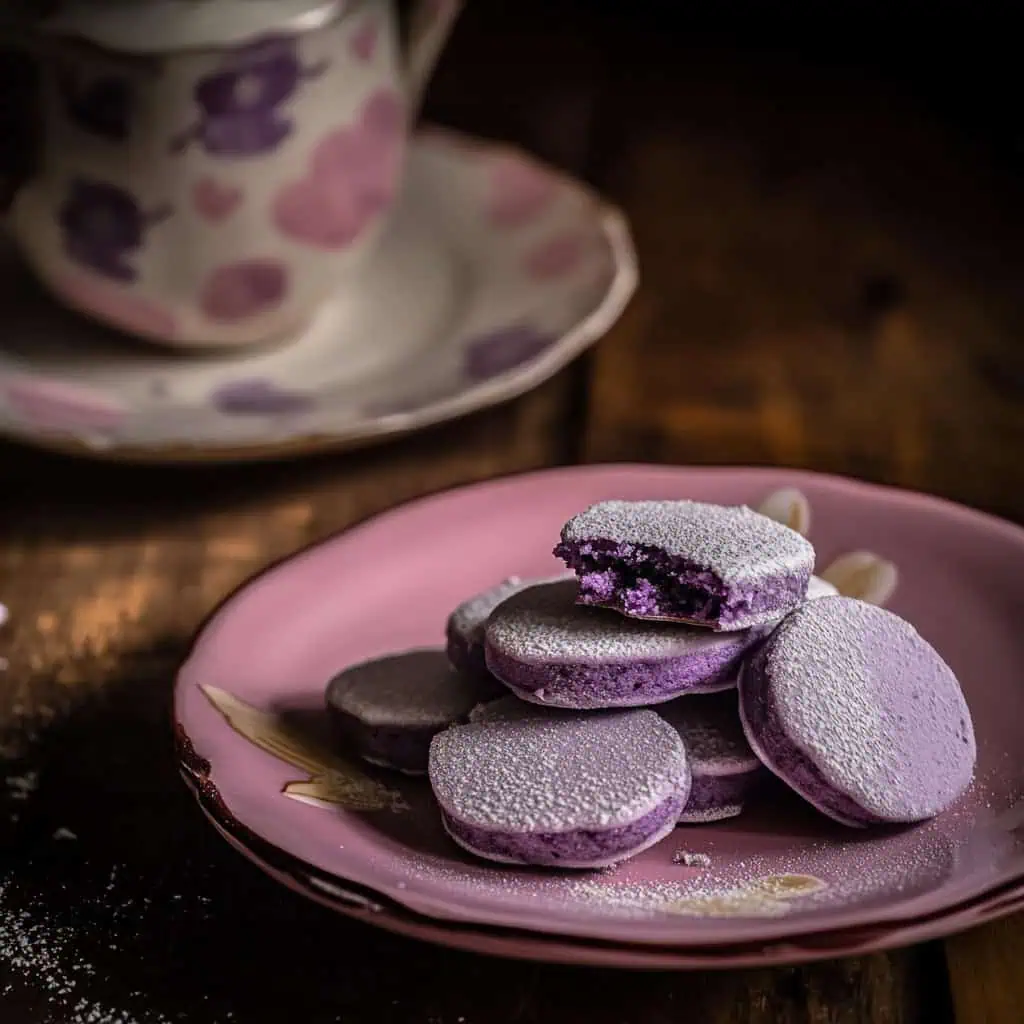






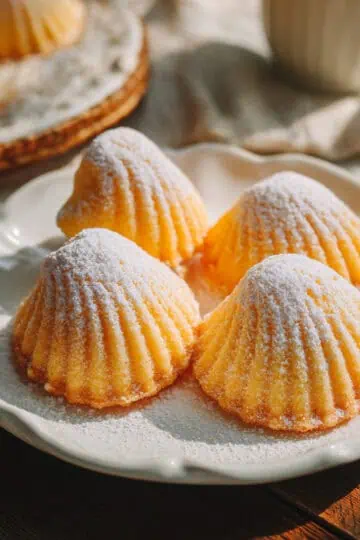
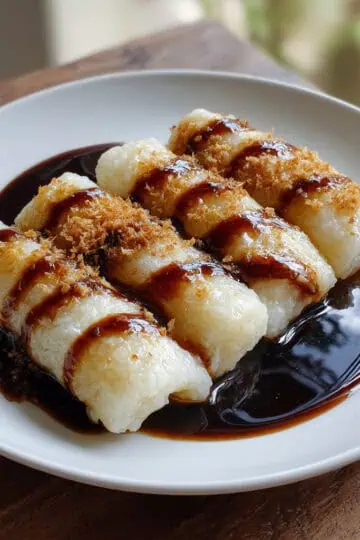

Comments
No Comments